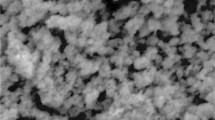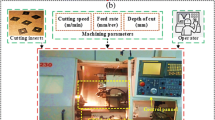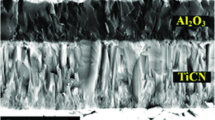Abstract
Plentiful supply of coolant might enhance the machining cost and also generates environmental hazard. As a result, substitute methods are required to eliminate the problems encountered during use of coolant. In this investigation, the impact of cutting speed, feed and lubrication conditions (dry: no lubrication, oil: machining is performed with groundnut oil and nano fluid: machining performed with copper nano fluid) on surface roughness, tool wear and chip morphology in turning of H 11 steel with minimum quantity lubrication (MQL) were examined. Experiments were conducted using L18 orthogonal array. The results reveal that copper nanofluids with MQL provide a substitute for dry and oil machining. Response surface methodology has been used to derive optimal values and mathematical models. Tool wear was reduced by 66% and surface roughness by 40% while machining with copper nano fluids. The surface roughness and tool wear were decreased under optimal machining conditions. Generation of large notched tooth in chips has been minimised with copper nano fluids. Furthermore, the morphology of the chips were analysed for dry, oil and nano fluid under scanning electron microscope to observe the texture created.





















Similar content being viewed by others
References
Sharma AK, Tiwari AK, Dixit AR (2016) Effects of minimum quantity lubrication (MQL) in machining processes using conventional and nanofluid based cutting fluids: a comprehensive review. J Clean Product 127:1–18
VamsiKrishna P, Srikant RR, NageswaraRao D (2010) Experimental investigation on the performance of nanoboricacid suspensions in SAE-40 and coconut oil during turning of AISI1040 steel. Int J Mach Tool Manu 50:911–916
Jianhua D, Tongkun C, Xuefeng Y, Jianhua L (2006) Self-lubrication of sintered ceramic tools with CaF2 additions in dry cutting. Int J Mach Tool Manuf 46:957–963
Dilbag S, Rao PV (2008) Performance improvement of hard turning with solid lubricants. Int J Adv Manuf Technol 38:529–535
Attanasio A, Gelfi M, Giardini C, Remino C (2006) Minimal quantity lubrication in turning: effect on tool wear. Wear 260:333–338
Lee PH, Nam JS, Lee SW (2012) An experimental study on micro-grinding process with nanofluid minimum quantity lubrication (MQL). Int J Precis Eng Man 13:331–338
Dhar NR, Ahmed MT, Islam S (2007) An experimental investigation on effect of minimum quantity lubrication in machining AISI 1040 steel. Int J Mach Tool Manuf 47:748–753
Khan MMA, Dhar NR (2006) Performance evaluation of minimum quantity lubrication by vegetable oil in terms of cutting force, cutting zone temperature, tool wear, job dimension and surface finish in turning AISI-1060 steel. J Zhejiang Univ Sci A 7:1790–1799
Leppert T (2012) Surface layer properties of AISI 316L steel when turning under dry and with minimum quantity lubrication conditions. Proc IMech E Part B J Eng Manuf 226:617–631
Vasu V, Pradeep Kumar Reddy G (2011) Effect of minimum quantity lubrication with Al2O3 nanoparticles on surface roughness, tool wear and temperature dissipation in machining Inconel 600 alloy. Proc IMech E Part N J Nano Eng Nanosyst 225:3–16
Marques A, Narala SKR, Machado AR, Gunda RK, Josyula SK, Da Silva RB, Da Silva MB (2015) Performance assessment of MSQL: minimum quantity solid lubricant during turning of Inconel 718. Proc IMech E Part B J Eng Manuf 231:1144–1159
Elmunafi MHS, Yusof NM, Kurniawan D (2015) Effect of cutting speed and feed in turning hardened stainless steel using coated carbide cutting tool under minimum quantity lubrication using castor oil. Adv Mech Eng 7:1–7
Amrita M, Srikant RR, Sitaramaraju AV (2014) Performance evaluation of nanographite-based cutting fluid in machining process. Mater Manuf Process 29:600–605
Wang Y, Li C, Zhang Y, Li B, Yang M, Zhang X, Guo S, Liu G (2016) Experimental evaluation of the lubrication properties of the wheel/workpiece interface in MQL grinding with different nanofluids. Trib Int 99:198–210
Sharma AK, Singh RK, Dixit AR, Tiwari AK (2016) Characterization and experimental investigation of Al2O3 nanoparticle based cutting fluid in turning of AISI 1040 steel under minimum quantity lubrication (MQL). Mater Today Proc 3:1899–1906
NarayanaRao S, Satyanarayana B, Venkatasubbaiah K (2011) Experimental estimation of tool wear and cutting temperatures in MQL using cutting fluids with CNT inclusion. Int J Eng Sci Technol 3:2928–2931
Sharma P, Sidhu BS, Sharma J (2015) Investigation of effects of nanofluids on turning of AISI D2 steel using minimum quantity lubrication. J Clean Prod 108:72–79
Huang WT, Wu DH, Lin SP, Chen JT (2014) Robust design of using MWCNTs in minimum quantity lubrication. Appl Mech Mater 670–671:11–21
Padmini R, Vamsi Krishna P, Krishna Mohana Rao G (2014) Performance assessment of micro and nano solid lubricant suspensions in vegetable oils during machining. Proc IMech E Part B J Eng Manuf 229:2196–2204
Mao C, Zhang J, Huang Y, Zou H, Huang X, Zhou Z (2013) Investigation on the effect of nanofluid parameters on MQL grinding. Mat Manuf Process 28:436–442
Prasad M, Srikant R (2013) Performance evaluation of nano graphite inclusions in cutting fluids with MQL technique in turning of AISI 1040 Steel. Int J Res Eng Tech 2:381–393
Sredanovic B, Lakic GG, Cica D, Kramar D (2013) Influence of different cooling and lubrication techniques on material machinability in machining. Strojniski vestnik J Mech Eng 59(12):748–754
Singh RK, Sharma AK, Dixit AR, Mandal A, Tiwari AK (2017) Experimental investigation of thermal conductivity and specific heat of nanoparticles mixed cutting fluids. Mater Today Proc 4:8587–8596
Sharma AK, Tiwari AK, Dixit AR (2016) Rheological behaviour of nanofluids: a review. Renew Sustain Rev 53:779–791
Singh RK, Sharma AK, Dixit AR, Tiwari AK, Pramanik A, Mandal A (2017) Performance evaluation of alumina-graphene hybrid nano-cutting fluid in hard turning. J Clean Product. https://doi.org/10.1016/j.jclepro.2017.06.104
Singh RK, Dixit AR, Mandal A, Sharma AK (2017) Emerging application of nano particle-enriched cutting fluid in metal removal processes: a review. Soc Mech Sci Eng, J Braz. https://doi.org/10.1007/s40430-017-0839-0
Sharma AK, Tiwari AK, Dixit AR, Singh RK, Singh M (2018) Novel uses of alumina/graphene hybrid nanoparticle additives for improved tribological properties of lubricant in turning operation. Tribol Int 119:99–111
Sharma AK, Singh RK, Dixit AR, Tiwari AK (2017) Novel uses of alumina-MoS2 hybrid nanoparticle enriched cutting fluid in hard turning of AISI 304 steel. J Manuf Process 30:467–482
Sharma AK, Tiwari AK, Dixit AR, Singh RK (2017) Investigation into performance of SiO2 nanoparticle based cutting fluid in machining process. Mater Today Proc 4:133–141
Sharma AK, Tiwari AK, Dixit AR, Singh RK, Dixit AR (2016) Tribological investigation of TiO2 nanoparticle based cutting fluid in machining under minimum quantity lubrication (MQL). Mater Today Proc 3:2155–2162
Derringer G, Suich R (1980) Simultaneous optimization of several response variables. J Q Technol 12:214–219
Gopalakannan S, Senthilvelan T (2013) Application of response surface method on machining of Al–SiC nano-composites. Measurement 46:2705–2715
Naresh Babu M, Muthukrishnan N (2017) Exploration on Kerf-angle and surface roughness in abrasive waterjet machining using response surface method. C, J Inst Eng India Ser. https://doi.org/10.1007/s40032-017-0366-x
Bhardwaj B, Kumar R, Singh PK (2013) Prediction of surface roughness in turning of EN 353 using response surface methodology. Trans Indian Inst Met 67:305–313
Priyadarshi D, Sharma RK (2016) Effect of type and percentage of reinforcement for optimization of the cutting force in turning of Aluminium matrix nanocomposites using response surface methodologies. J Mech Sci Technol 30:1095–1101
Lin YC, Tsao CC, Hsu CY, Hung SK, Wen DC (2012) Evaluation of the characteristics of the microelectrical discharge machining process using response surface methodology based on the central composite design. Int J Adv Manuf Technol 62:1013–1023
Vasu V, Pradeep Kumar Reddy G (2011) Effect of minimum quantity lubrication with Al2O3 nanoparticles on surface roughness, tool wear and temperature dissipation in machining Inconel 600 alloy. Proc IMech E Part N J Nanoeng Nanosyst. https://doi.org/10.1177/1740349911427520
Santhanakumar M, Adalarasan R, Siddharth S, Velayudham A (2016) An investigation on surface finish and flank wear in hard machining of solution treated and aged 18% Ni maraging steel. Sci Eng, J Braz Soc Mech. https://doi.org/10.1007/s40430-016-0572-0
Manimaran R, Palaniradja K, Alagumurthi N, Sendhilnathan S, Hussain J (2014) Preparation and characterization of copper oxide nanofluid for heat transfer applications. Appl Nano Sci 4:163–167
Ravi S, Pradeep Kumar M (2011) Experimental investigations on cryogenic cooling by liquid nitrogen in the end milling of hardened steel. Cryogenics 51:509–515
Dhar NR, Islam MW, Islam S, Mithu MAH (2006) The influence of minimum quantity of lubrication (MQL) on cutting temperature, chip and dimensional accuracy in turning AISI-1040 steel. J Mat Pro Technol 171:93–99
Khana MMA, Mithua MAH, Dhar NR (2009) Effects of minimum quantity lubrication on turning AISI 9310 alloy steel using vegetable oil-based cutting fluid. J Mater Proc Techn 209:5573–5583
Padmini R, VamsiKrishna P, Krishna Mohana Rao G (2016) Effectiveness of vegetable oil based nanofluids as potential cutting fluids in turning AISI 1040 steel. Tribol Int 94:490–501
Kalaimathi M, Venkatachalam G, Sivakumar M (2014) Experimental investigations on the electrochemical machining characteristics of monel 400 alloys and optimization of process parameters. Jordan J Mech Ind Eng 8:143–151
Gupta MK, Sood PK, Sharma VS (2016) Machining parameters optimization of titanium alloy using response surface methodology and particle swarm optimization under minimum quantity lubrication environment. Mater Manuf Process 31:1671–1682
Khandekar S, Ravi Sankar M, Agnihotri V, Ramkumar J (2012) Nano-cutting fluid for enhancement of metal cutting performance. Mater Manuf Process 27:963–967
Kakac S, Pramuanjaroenkij A (2016) Single-phase and two-phase treatments of convective heat transfer enhancement with nanofluids—a state-of-the-art review. Int J Therm Sci 100:75–97
Jia D, Li C, Zhang Y, Yang M, Wang Y, Guo S, Cao H (2017) Specific energy and surface roughness of minimum quantity lubrication grinding Ni-based alloy with mixed vegetable oil-based nanofluids. Precis Eng 50:248–262
Raju RA, Andhare A, Sahu NK (2017) Performance of multi walled carbon nano tube based nanofluid in turning operation. Mat Manuf Process 32:1490–1496
Mahboob Ali MA, Azmi AI, Mohd Khalil AN, Leong KW (2017) Experimental study on minimal nanolubrication with surfactant in the turning of titanium alloys. Int J Adv Manuf Technol 92:117–127
Priyadarshi D, Sharma RK (2015) Optimization for turning of Al-6061-SiCGr hybrid nanocomposites using response surface methodologies. Mat Manuf Process 31:1342–1350
Muthukrishnan N, Murugan M, Prahlada Rao K (2008) Machinability issues in turning of Al-SiC (10p) metal matrix composites. Int J Adv Manuf Technol 39(3):211–218
Ciftci I, Turker M, Seker U (2004) CBN cutting tool wear during machining of particulate reinforced MMCs. Wear 257(9–10):1041–1046
Khettabi R, Nouioua M, Djebara A, Songmene V (2017) Effect of MQL and dry processes on the particle emission and part quality during milling of aluminum alloys. Int J Adv Manuf Technol 92(5–8):2593–2598
Zulay C, Yidney P, Patricia ME (2004) Built-up edge effect on tool wear when turning steels at low cutting speed. J Mater Eng Perform 13(5):542–547
Author information
Authors and Affiliations
Corresponding author
Ethics declarations
Conflict of interest
The authors declare no potential conflicts of interest with respect to the research, authorship and/or publication of this article.
Additional information
Technical Editor: Márcio Bacci da Silva.
Rights and permissions
About this article
Cite this article
Ganesan, K., Naresh Babu, M., Santhanakumar, M. et al. Experimental investigation of copper nanofluid based minimum quantity lubrication in turning of H 11 steel. J Braz. Soc. Mech. Sci. Eng. 40, 160 (2018). https://doi.org/10.1007/s40430-018-1093-9
Received:
Accepted:
Published:
DOI: https://doi.org/10.1007/s40430-018-1093-9




